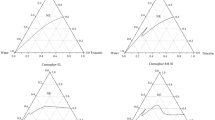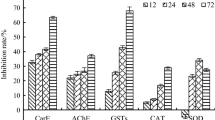Abstract
BB5, an alkyl phenoxy polyethylene ethanol formulated in acidic buffer, is an adjuvant added usually to various pesticides to potentiate their activities on various biological systems. Addition of 0.2% BB5 resulted in a considerable increase of thiamethoxam toxicity onBemisia tabaci (Gennadius) nymphs. According to LC50 values, the combined effect was over 25-fold higher than that of thiamethoxam alone. On the other hand, no appreciable combined effect was observed when BB5 and thiamethoxam were applied together onB. tabaci adults. The importance of these results is discussed.
Similar content being viewed by others
References
Elbert, A. and Nauen, R. (2004) New applications for neonicotinoid insecticides using imidacloprid as an example.in: Horowitz, A.R. and Ishaaya, I. [Eds.] Insect Pest Management: Field and Protected Crops. Springer-Verlag, Berlin, Germany. pp. 29–44.
Elbert, A., Nauen, R. and Leicht, W. (1998) Imidacloprid, a novel chloronicotinyl insecticide: biological activity and agricultural importance.in: Ishaaya, I. and Degheele, D. [Eds.] Insecticides with Novel Modes of Action: Mechanism and Application. Springer-Verlag, Berlin, Germany. pp. 287–310.
Horowitz, A.R. and Ishaaya, I. (2004) Biorational insecticides — mechanism, selectivity and importance in pest management.in: Horowitz, A.R. and Ishaaya, I. [Eds.] Insect Pest Management: Field and Protected Crops. Springer-Verlag, Berlin, Germany. pp. 1–28.
Ishaaya, I. (2001) Biochemical processes related to insecticide action: an overview.in: Ishaaya, I. [Ed.] Biochemical Sites of Insecticide Action and Resistance. Springer-Verlag, Berlin, Germany. pp. 1–16.
Liu, M-Y. and Casida, J.E. (1993) High affinity binding of [3H]-imidacloprid in the insect acetylcholine receptor.Pestic. Biochem. Physiol. 46:40–46.
Liu, T-X and Stansly, P.A. (2000) Insecticidal activity of surfactants and oils against silverleaf whitefly (Bemisia argentifolii) nymphs (Homoptera: Aleyrodidae) on collards and tomato.Pest Manag. Sci. 56:861–866.
Nauen, R., Ebbinghaus-Kintscher, U., Elbert, A., Jeschke, P. and Tietjen, K. (2001) Acetylcholine receptors as sites for developing neonicotinoid insecticides.in: Ishaaya, I. [Ed.] Biochemical Sites of Insecticide Action and Resistance. Springer-Verlag, Berlin, Germany. pp. 77–105.
Plant Products (2004) BB5-Acidifier and pH indicator. http://www.plantprod.com/catalogue/17miscellaneous.html.
Tomizawa, M., Otsuka, H., Miyamoto, T., Eldefrawi, M.E. and Yamamoto, I. (1995) Pharmacological characteristics of insect nicotinic acetylcholine receptor with its ion channel and the comparison of the effect of nicotinoids and neonicotinoids.J. Pestic. Sci. 20:57–64.
Tomizawa, M., Otsuka, H., Miyamoto, T. and Yamamoto, I. (1995) Pharmacological effects of imidacloprid and its related compounds on the nicotinic acetylcholine receptor with its ion channel from theTorpedo electric organ.J. Pestic. Sci. 20:49–56.
Tomizawa, M. and Yamamoto, I. (1992) Binding of neonicotinoids and the related compounds to the insect nicotinic acetylcholine receptor.J. Pestic. Sci. 17:231.
Witt, J.M. (2004) Agricultural spray adjuvants. http://pmep.cce.cornell.edu/facts/gen-peapp-adjuvants.html.
Yamamoto, I. and Casida J.E. [Eds.] (1999) Nicotinoid Insecticides and the Nicotinic Acetylcholine Receptor. Springer-Verlag, Tokyo, Japan.
Yamamoto, I., Yabuta, G., Tomizawa, M., Saito, T., Miyamoto, T. and Kagabu, S. (1995) Molecular mechanism of selective toxicity of nicotinoids and neonicotinoids.J. Pestic. Sci. 20:33–40.
Author information
Authors and Affiliations
Corresponding author
Additional information
http://www.phytoparasitica.org posting Dec. 20, 2004.
Rights and permissions
About this article
Cite this article
Ishaaya, I., Kontsedalov, S. & Horowitz, A.R. Note: Effect of the surfactant BB5 on the potency of thiamethoxam against the whiteflyBemisia tabaci . Phytoparasitica 33, 57–59 (2005). https://doi.org/10.1007/BF02980925
Received:
Accepted:
Issue Date:
DOI: https://doi.org/10.1007/BF02980925




